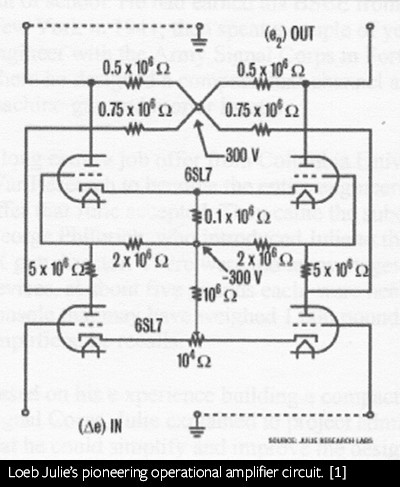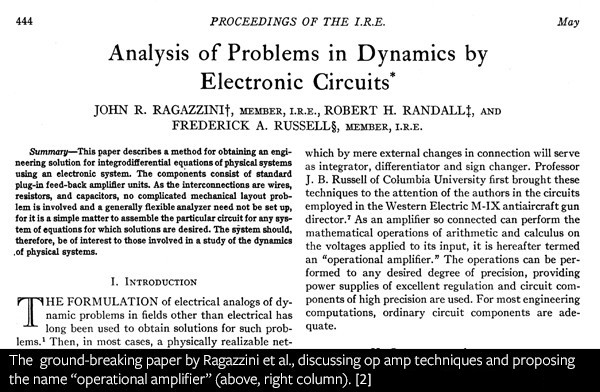
The history of operational amplifier (op amp) development at Columbia is a little unusual. Our department had hired John Ragazzini as a faculty member during WWII; he had obtained his PhD from Columbia in 1941, the year the United States entered WWII. Ragazzini created a group that became very well-known for its work on control systems. One of the activities of the group, under a contract from the National Defense Research Council, involved analog computers, a main application of which at the time was in “gun directors” – systems that perform real-time computations for automatically aiming anti-aircraft guns. At the time, high-gain circuits were used for this purpose, notably at Bell Laboratories, as part of negative feedback systems. But those systems were too slow, bulky, and power-hungry.
Enter Loebe Julie, a young engineer hired by Ragazzini, who had graduated from New York’s City College and had spent some time with the Army Signals Corp. He proposed to develop smaller, must faster high-gain circuits, with a “differential” input (a + input and a – input) – a feature that later became key to the success of op amps. For reasons that are not clear, Ragazzini did not want Julie to work on this problem. But George Philbrick, a physicist from MIT who was looking to subcontract part of the work he was doing for the National Defense Research Council, visited Columbia and had a talk with Julie, who explained his idea to him. Impressed, Philbrick asked Julie how long it would take for him to develop this idea. Julie said he would need one month. With that, Philbrick asked Ragazzini to allow Julie to work on this project. He did, but bitterness between Ragazzini and Julie ensued.
In one month, Julie had a prototype of a high-gain differential amplifier. The circuit was over one hundred times faster than existing circuits, and consumed much less power. Philbrick ordered multiple units that were quickly incorporated into the M-9 Gun Director, and proved to be very successful.
In 1947, Ragazzini and two co-authors, Robert Randall and Fred Russell, published a paper in the Proceedings of the IRE, which was destined to become a classic. Titled “Analysis of Problems in Dynamics by Electronic Circuits”, it proposed the “operational amplifier” name, justifying this name by noting that the circuit, together with other components, can perform mathematical operations. The paper then reviewed several key circuits using op amps. This paper was key to spreading op amp applications, which within a few years became ubiquitous. But Loebe Julie was not a co-author of the paper, and his circuit was not included in it; he is only mentioned in the acknowledgments, for “some phases of this development”. Julie soon left, and later started Julie Research Laboratories, which produced high-precision components and instruments.

Sources
- J. R. Ragazzini, R. H. Randall, and F. A. Russell, “Analysis of problems in dynamics by electronic circuits”, Proceedings of the IRE, vol. 35, May 1947, pp. 444-452.
- G. Rostky, “Unsung hero pioneered op amp”, EE Times, March 24, 1997; https://www.tayloredge.com/museum/museum/opamp.pdf
- B. Pease, “What’s all this Julie stuff, anyhow?”, Electronic Design, May 3, 1999; https://www.electronicdesign.com/analog/whats-all-julie-stuff-anyhow
- http://www.philbrickarchive.org
Image Credits
[1] Design Classics (https://tayloredge.com/museum/museum/opamp.pdf). Accessed 8/26/21.
[2] Proceedings of the IRE, vol 35, May 1947, pp 444-452.